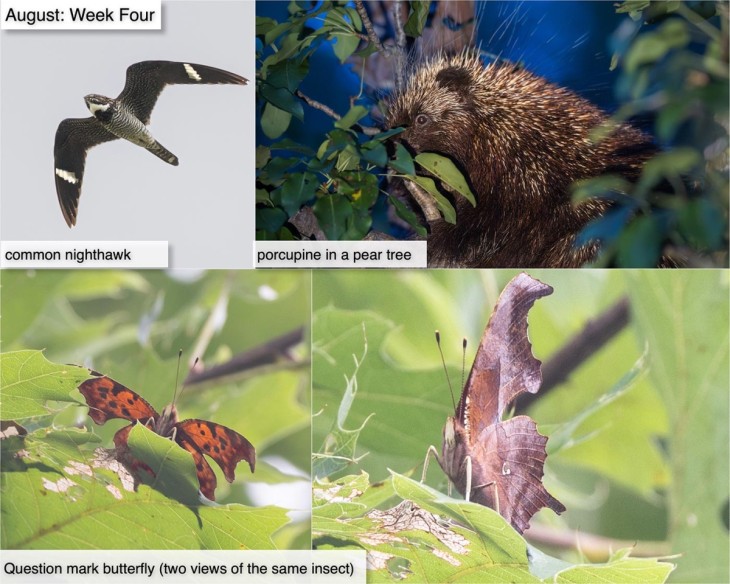This week in the woods, common nighthawks are migrating down the Connecticut River corridor, and if you look up at twilight, you may catch a glimpse of them performing acrobatic dives and swoops. (Thanks to Tig Tillinghast for this long distance shot of one of the birds flying above a field along the Ompompanoosuc River.) The birds are hunting high altitude insects, also known by scientists as “aerial plankton.” As Colby Galliher noted in this recent Outside Story essay, common nighthawks fit the classic body type for birds that hunt insects in the air. They have relatively large wings compared to their body size, which makes their flight efficient and gives them a great deal of maneuverability; for example, a high wing-to-body ration allows them to make abrupt turns without stalling. Their pointed wings are also built for efficiency, and speed, by minimizing drag around the wing tips.
Apple and pear trees are attracting wildlife, as the rush to fatten up for winter begins. We found a pear tree under double attack, with deer feasting on the fruit of lower branches, and this porcupine perched in the upper branches, noshing on fruit that the deer couldn’t reach. Here’s an essay by Northern Woodlands’ Associate Editor Meghan McCarthy McPhaul, describing her observations of wild visitors to her unruly orchard of “Prohibition trees.”
We’ve also been seeing an abundance of anglewing (Polygonia) butterflies, so named for the jagged profile of their wings. There are several species in our region and they look very similar to each other: orange with spots on top, and mottled brown below, so that when they close their wings above their backs, they blend in with dead leaves. This question mark butterfly perched in the foliage of an oak tree, providing a great opportunity to observe it from different aspects. As you can see in the photos, the coloring under the wings is almost transparent, so that when the butterfly opened its wings and sunlight illuminated it from above, its orange above wing color showed through. When it closed its wings, the brown markings reappeared.
If you look closely at the photo in the area above the butterfly’s middle leg “knee,” you’ll see a small white mark. The specific shape of this marking (supposedly resembling a question mark) and the spot pattern on its upper wings help to distinguish it from other Polygonia species. Anglewings feed and on sap and rotting fruit, so you may see them in fruit orchards, too.
What have you noticed in the woods this week? Submit a recent photo for possible inclusion in our monthly online Reader Photo Gallery.



Discussion *